Alright, time for the best show of the season. My evangelizing has already begun in earnest – last night, I ended up watching the first two episodes again (1 and 2, skipping 0) with one of my housemates. Which, first of all, let me notice a few more nice details in this very well-designed piece. Yase’s lines in the first episode are great, and gain a retroactive poignance given the events of her own episode – when asked if she likes it in the Mirror Capital, she says “Yeah! I love being with Mom, and fun stuff happens all the time. Like that train station that just opened!” Ouch. Koto’s fox-father also wears a mask strongly reminiscent of the one worn by the priest who banished the first Myoe, and at this point it seems beyond question that her fox is Myoe himself.
But beyond seeing more clever details, just letting the show do its thing this second time really ground in exactly how strong this overall production is. There’s just no comparison – if most shows are daytime television, this is film. The aesthetic, the writing, the direction… it’s all great, and the show makes no mistakes.
Which made me think of Eccentric Family, and the kinds of storytelling I really like in anime. Because even though this show’s aesthetics are unimpeachable, it’s hard to deny that this is my kind of storytelling. Letting a world and its conflicts emerge naturally from the slow illustration of characters and the bonds between them. Obviously it takes more than that – I mean, the writing has to be good, for one thing… and I certainly enjoy other genres, too. But when people say “nothing happens” in these shows, it’s difficult for me to even conceive. To me, pure action is nothing. Pure plot is nothing. It’s just empty calories, and I can’t bring myself to care about events just because those events are taking place. Given a choice of watching ciphers go on busy adventures or a handful of people I understand deal with one or two important events… yeah, that’s not a question. I mean, this is how books work – great novels don’t distract you with a shiny new bauble every chapter. They let their craft be their collateral, and tell the story they want to tell in the time it will take to tell it.
Not that this show abandons the strengths of television – it’s clearly making great use of the episodic structure, too. But that slow, confident build is something I too rarely see in a medium that to me seems incredibly well-suited to it.
Anyway. Enough rambling. Off to the Mirror City.
Episode 5
2:20 – Well that’s a big ol’ wall of text to start us off with. Already seems relevant to Myoe, so I guess that’s where we’re going
3:35 – Dear lord. That’s one way to start an episode. The music is very effective here
3:56 – I love all the little human gestures of the characters. There’s another thing that reminds me of Eccentric Family – all the characters’ mannerisms and physical ticks are critical to constructing their identity. You don’t needthis stuff to make believable characters, but it makes everyone feel much more alive if their physical habits reflect their nature
4:15 – Koto gets the best faces
4:37 – Although the expressions in general are great in this show
6:05 – They always keep these conversations very dynamic. This also seems like it might be the central hurdle here – in the absence of their parents, each of the siblings has retreated into their own private empire. So will Koto bring them together? Last episode already saw her acting as the conciliatory force between Yase and Kurama. But that kinda seems too simple, and doesn’t really address the theme of being trapped in the past or unable to grow up
6:34 – I like how we’re seeing him from his siblings’ perspectives. That scene with the soda was pretty telling – he’s not the type to discuss or confront his emotions. Whereas Yase’s completely transparent, and Kurama’s more of a big talker than he’d first appear
7:36 – A cynical view, very true to Kurama’s personality. So what, he thinks his brother is too much of a coward to take responsibility for his own life? Well, he would, wouldn’t he – unlike Myoe, he’s actively working to bring about the end of this place
8:04 – Another nice expression from Myoe. That rakish appeal
9:12 – A nice background. And again, the character posture is great
9:44 – Who are you talking about, Myoe?
10:05 – Who are you angry at, Myoe?
10:12 – Man, they’re handling this so well. Is he trapped by the beads, or are they just an excuse? Which is a great metaphor for people’s relationships with their parents’ legacies and expectations in general
10:36 – More of these backgrounds
10:55 – Straight to the point!
11:44 – Not the most emotionally perceptive, but not totally blind either
12:10 – I definitely like shows where the villain is “our inability to escape the shadow of ours parents’ legacy” or something
12:39 – Is this his fear, or wish? That he stand abandoned, watching the house of his parents burn, his responsibility destroyed before his eyes
13:14 – The animation is great here. Specifity of gestures in key emotional moments like this is one of the best possible uses of precise animation – something KyoAni know well
13:53 – It is a very selfish request. Not that most parents need to actually say it out loud
14:26 – These quiet scenes are always so good. At least the actual dog looks happy!
14:54 – Adorable
15:31 – As if stuff like this could offend Koto
17:19 – They’re also adorable together. I like Kurama advertising his giant robot and goon squad
17:39 – Looping back to the vending machine. They have so much in common
17:57 – Gah, this show’s visual design, direction, and sound design are all so good
18:36 – Once more, from the other side. Another year of duty passes, another chance to throw it away lost
20:03 – God damn, this show.
20:44 – “The beginning and the ending.” Oh boy. Not the promise he’d hoped for, though she may still bring the family together. Looks like he’s going to have to figure things out without waiting for the eventual acknowledgment of his father
22:18 – And Myoe catches up with the rest of the class
22:45 – Alright, what’s the deal with the damn pomegranate? They focused on it on the train as it was leaving, too. Did I miss this before? Does this have some Alice-related significance I’ve forgotten? Are we actually adding Greek symbolism to this mythology-mixture (I mean, that actually does work – it was the fruit that tied Persephone to the underworld, and the beads tie Myoe to this dead world)? Or can we just consider it a marker of their shared burden?
23:16 – So it was real. So there’s the reason he refers to old Myoe as “the priest”… and it also creates a certain distance between him and the siblings of his adopted family
24:02 – Myoe nooo
And Done
Jeez, that was a heavy friggin episode. So I guess Myoe’s feelings of displacement and purposelessness run much deeper than his relationship with the priest. Whatever happiness he once felt among his adopted family, it’s gone now – now he lives because he made a promise, and really is waiting to die. No wonder Miss Girlfriend asked Koto to save him – he’s not just trapped, he’s suicidal.
Not that he feels entirely displaced from his family – he did call the black rabbit “our mother,” after all. Though he may feel some odd responsibility to join his original parents, he does not deny the reality of his adopted ones (though he challenged Koto on this with regards to A and Un, as he did with basically everything they had in common this episode). And I guess the priest’s request turns out to not be selfish after all, and perhaps intended to save his son.
Well, we’ve got our characters, our relationships, our world, and our conflicts. I hope this turns out okay. I like this family an awful lot.

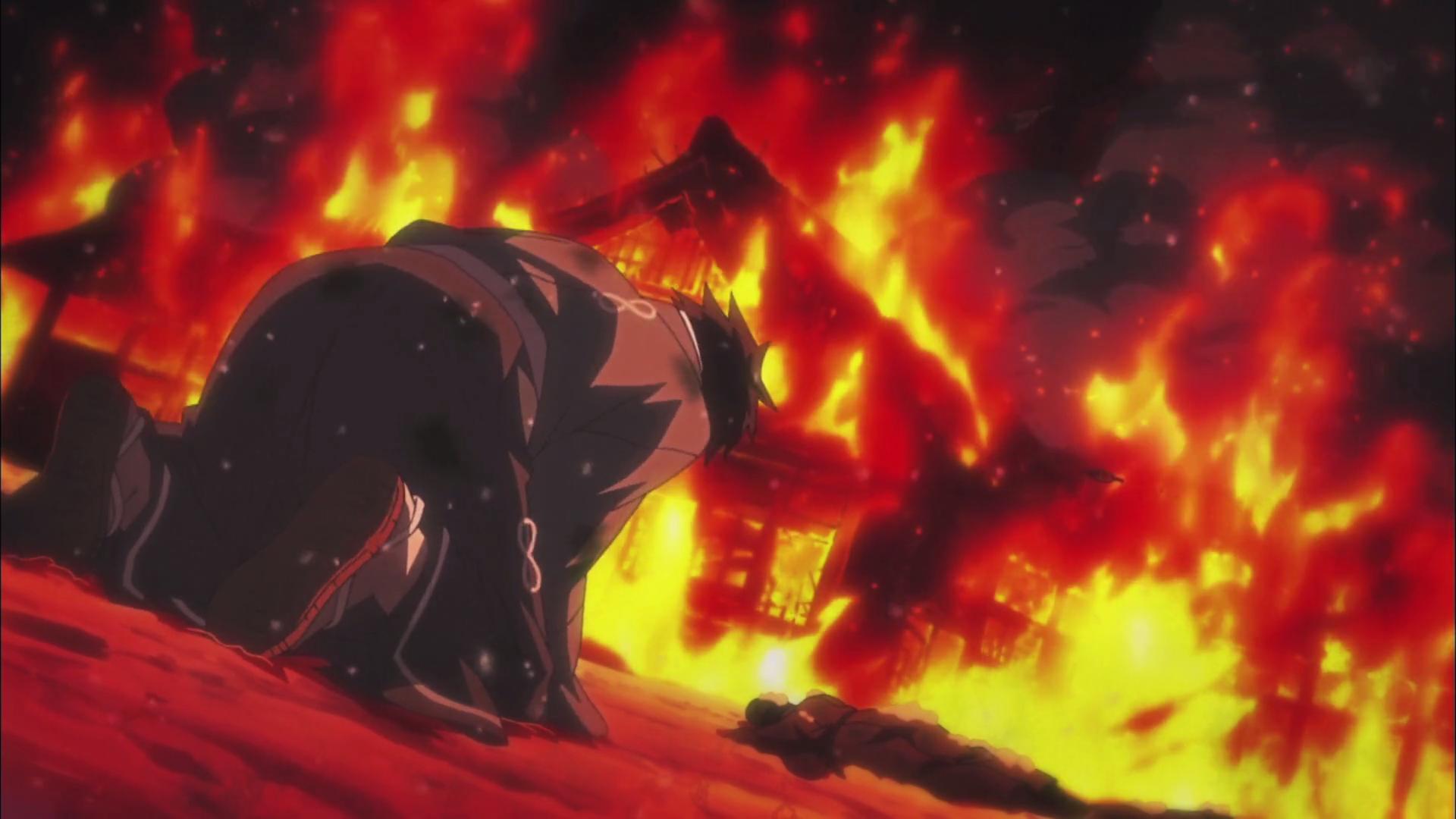
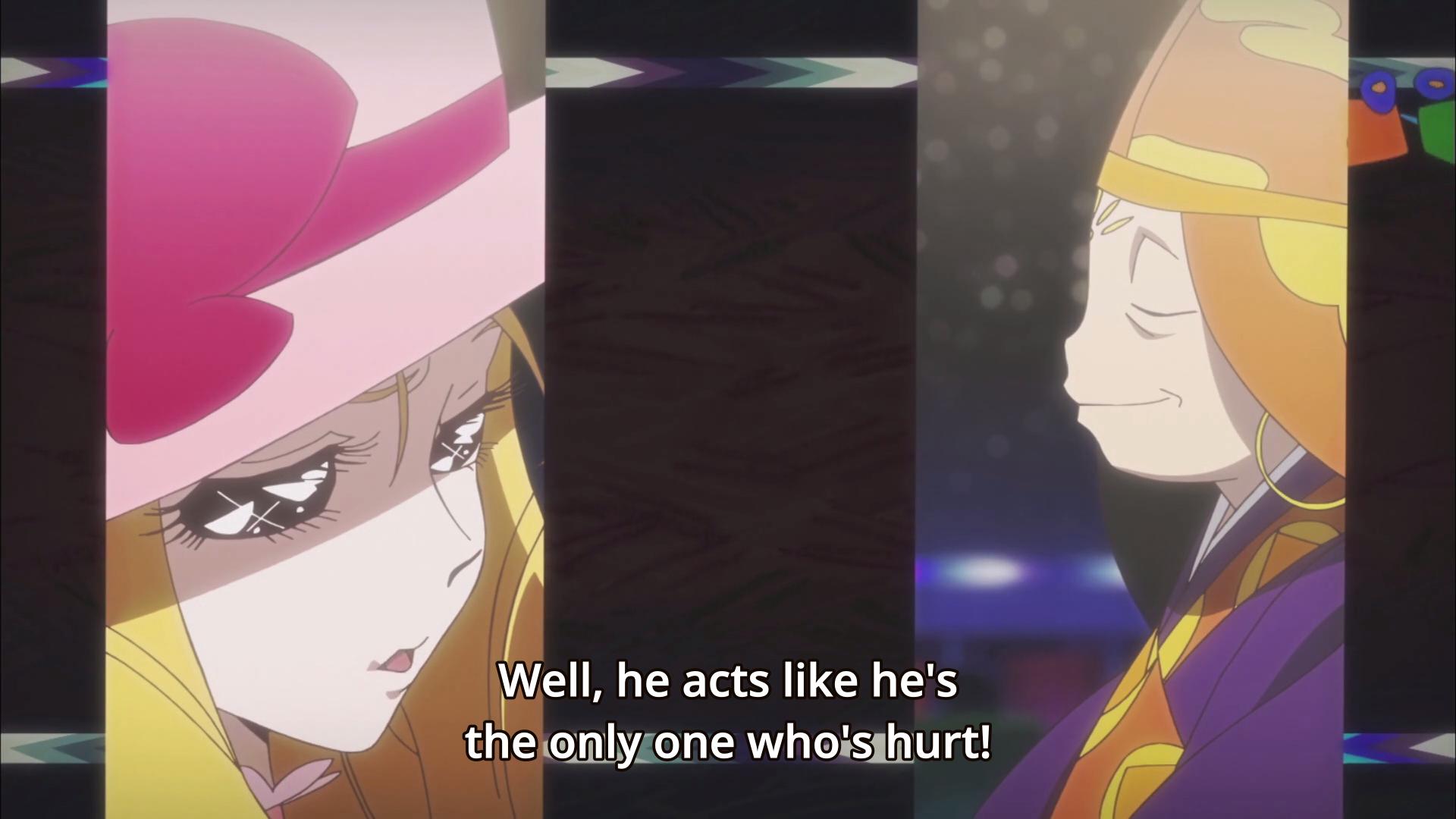
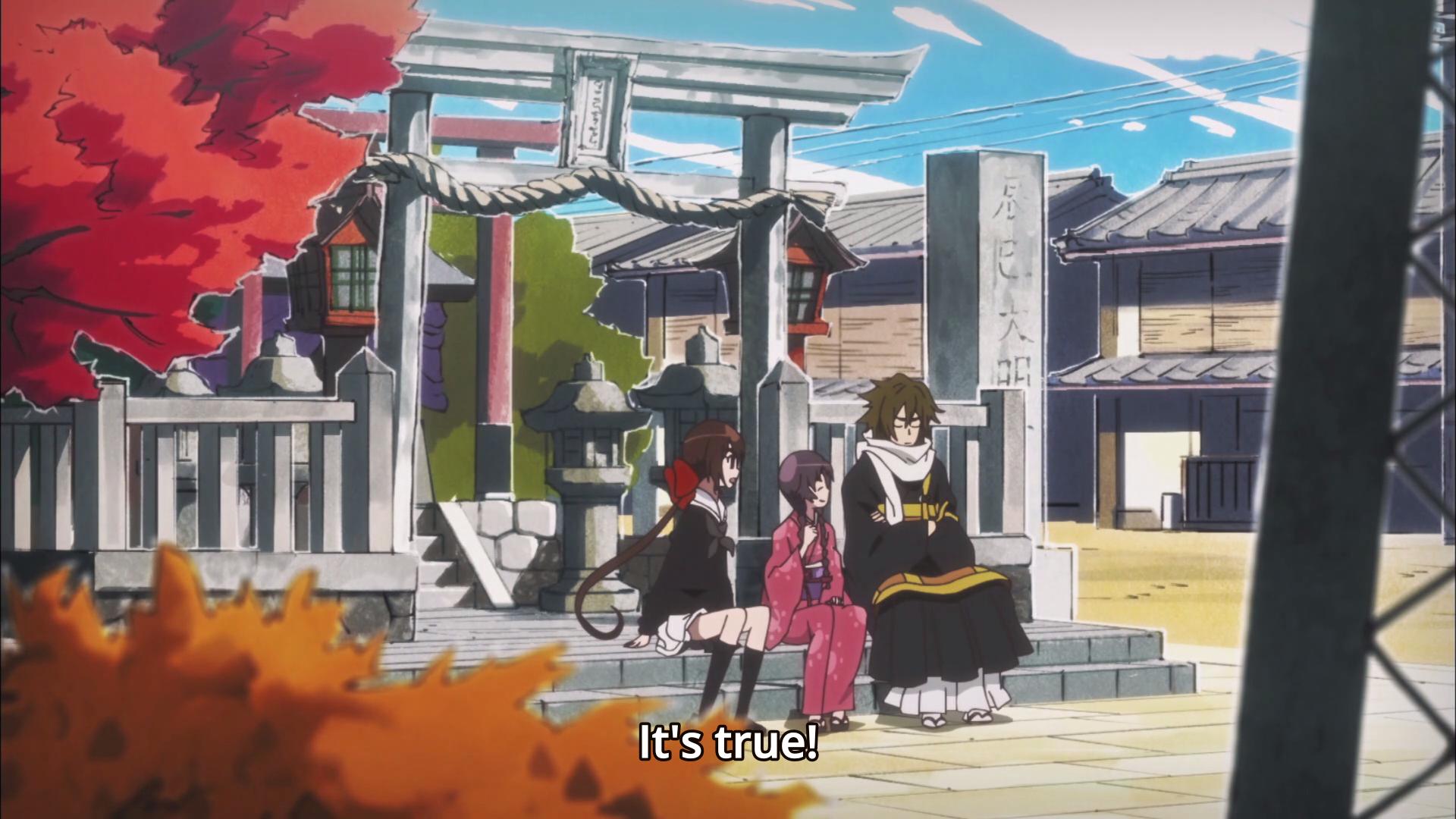
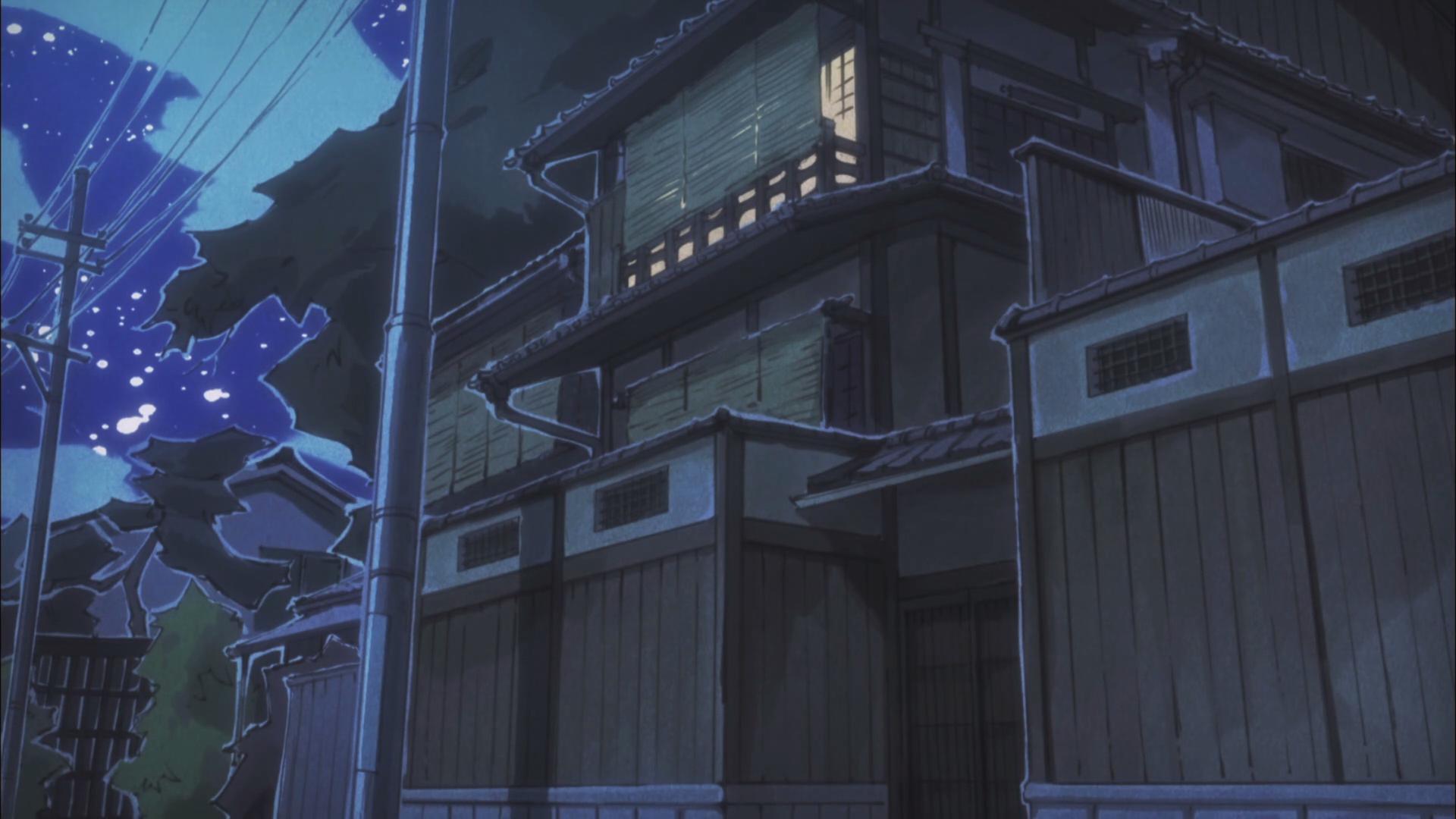
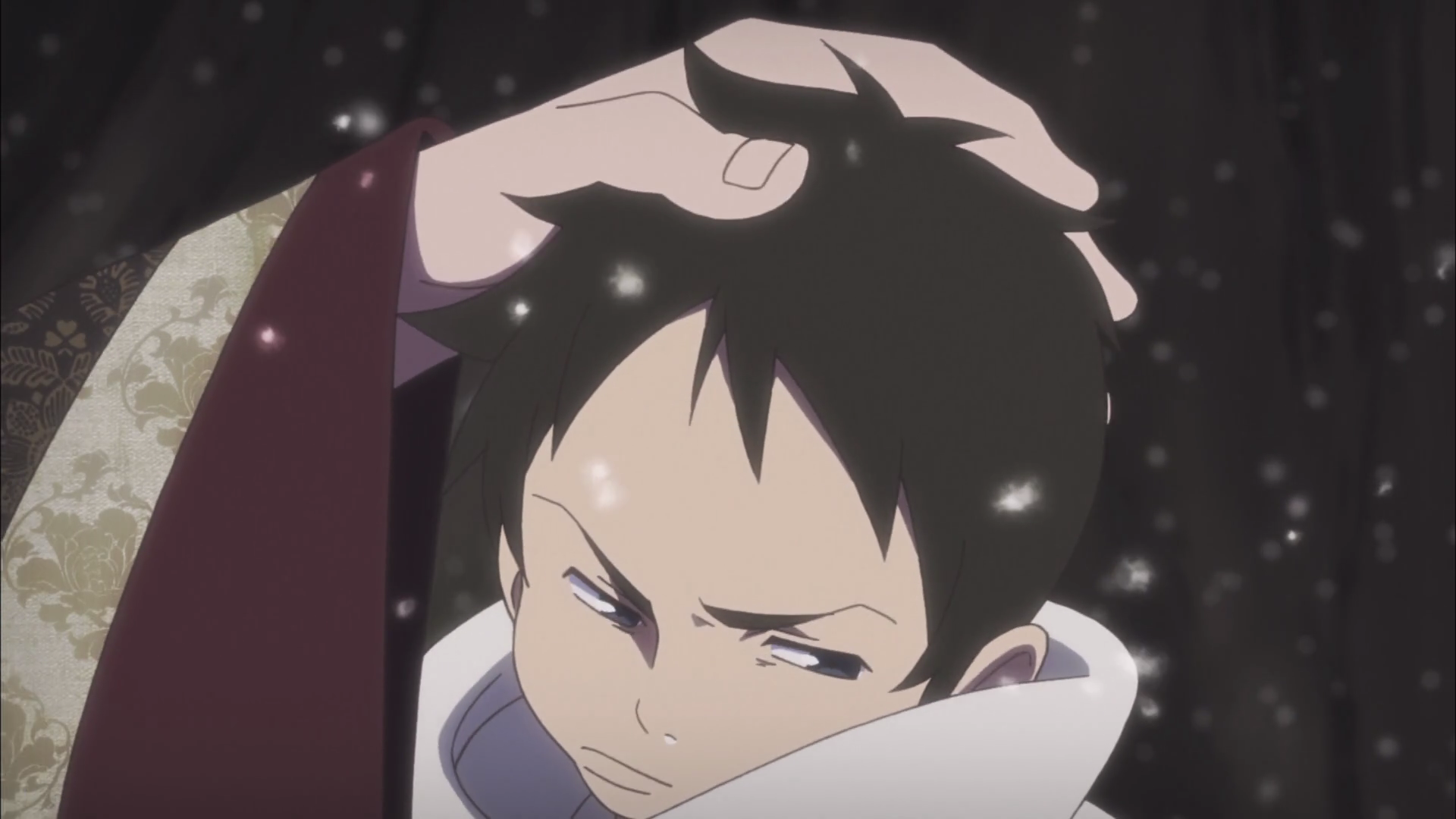
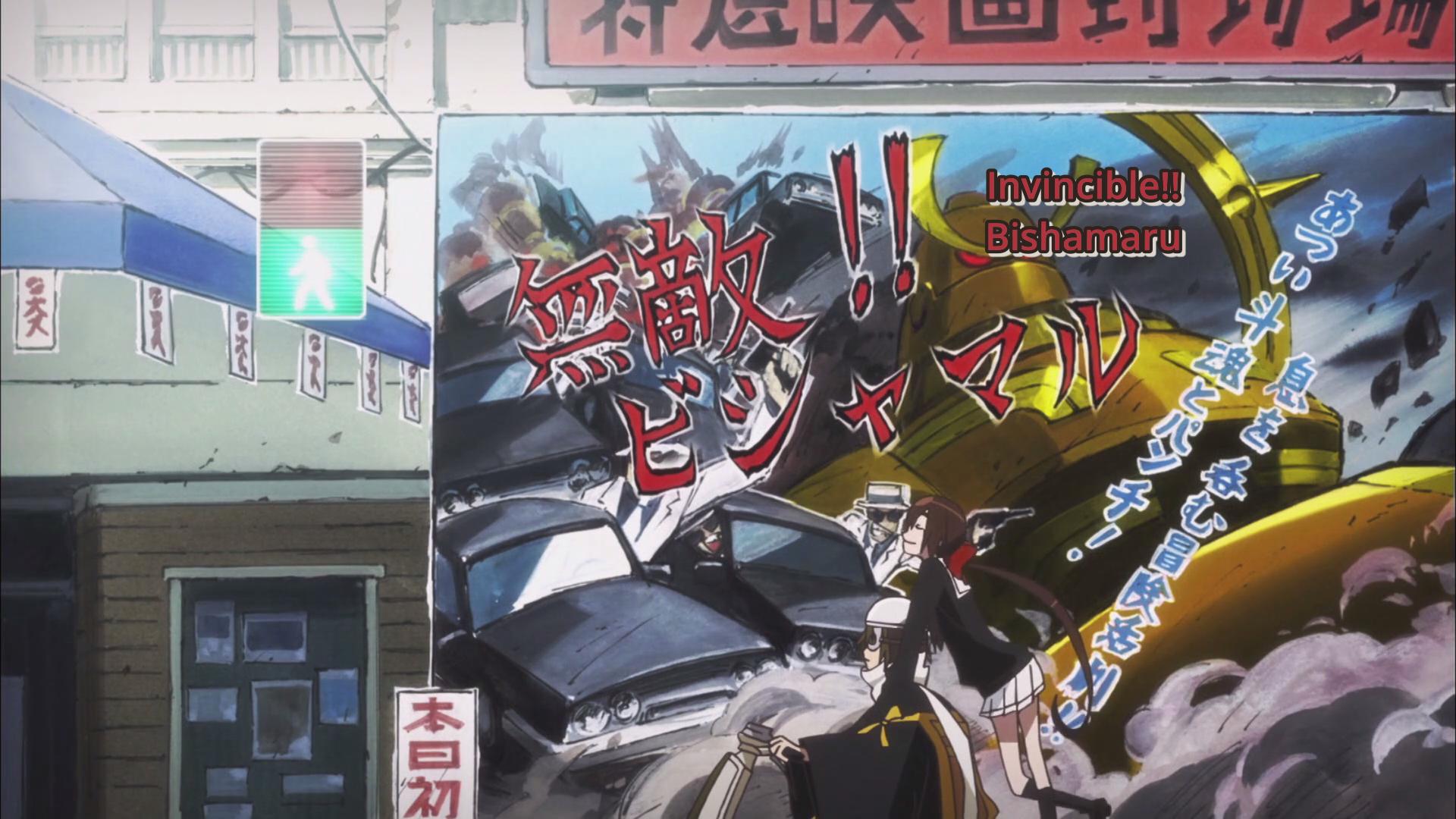
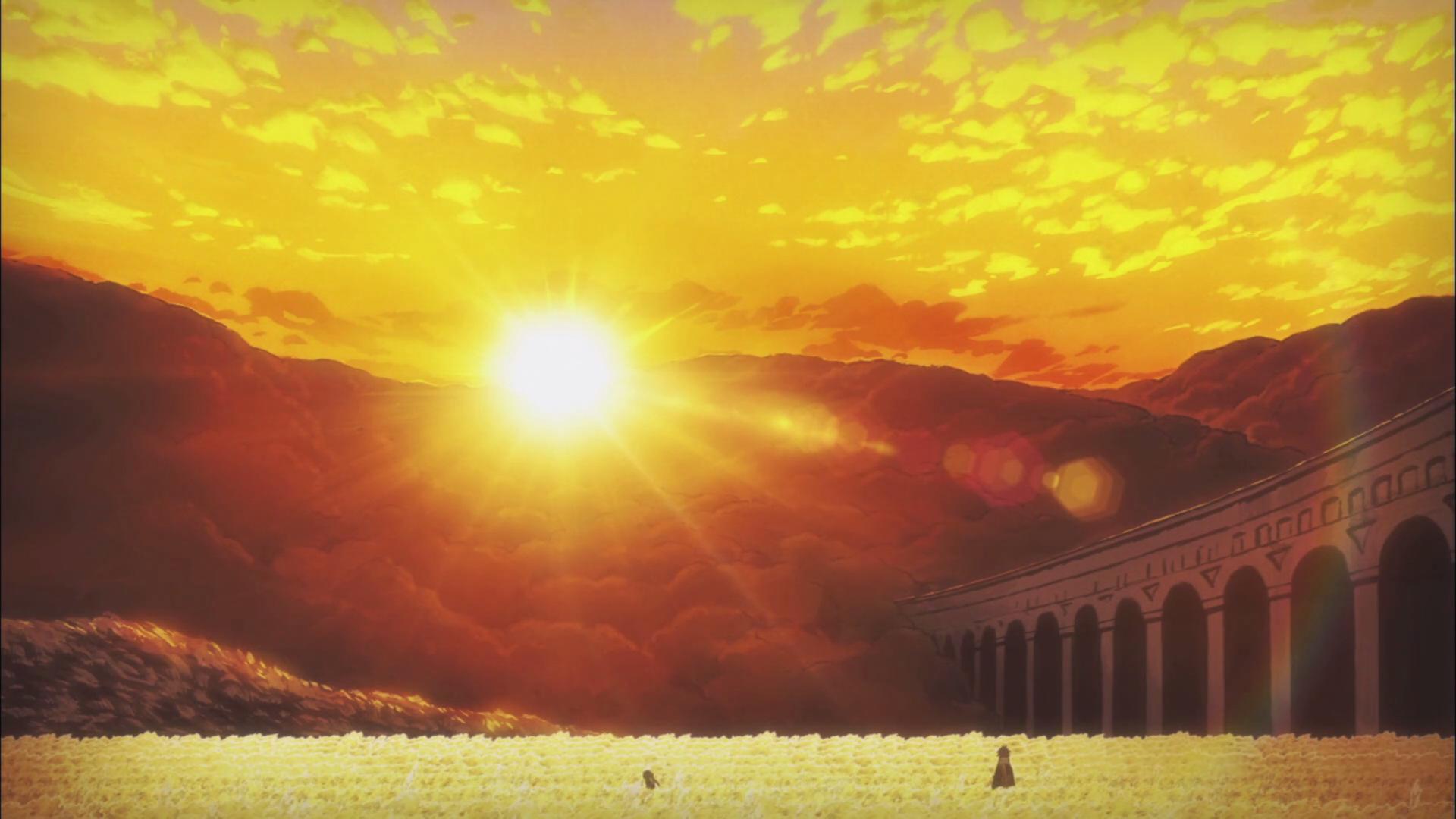
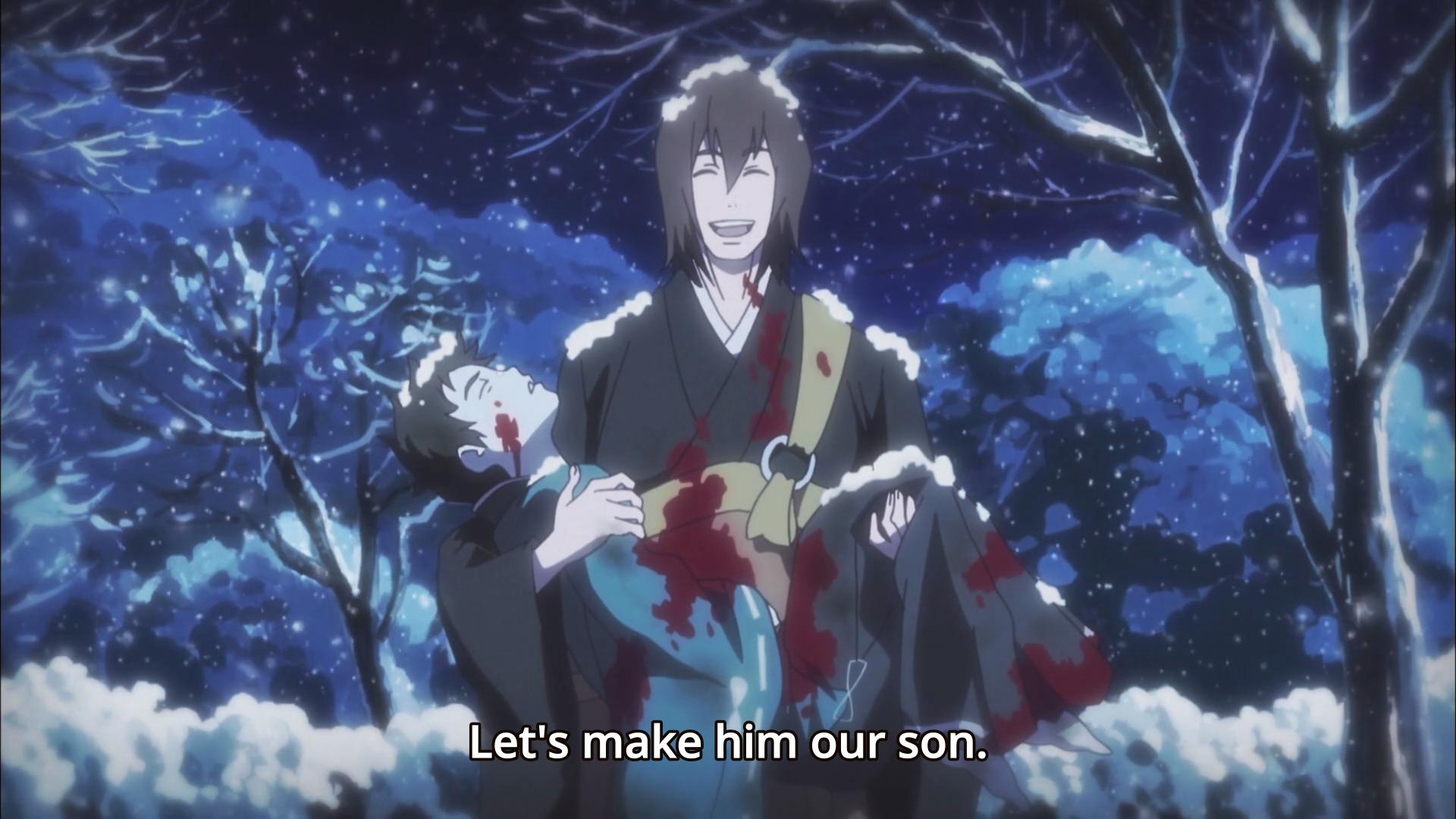
The pomegranate imagery is interesting. Quoting myself from the discussion thread on reddit:
“Symbolism, symbolism everywhere. The most simple interpretation is that the giving of the pomegranate just signifies an unspecified pact between Myoue and Koto.
A more far-fetched interpretation is that the pomegranate symbolises fertility(as it did in ancient Chinese folklore). By giving it to Koto, Myoue is basically saying ‘Become our mother(and father), end the world and remake it as you did before by creating all of us’.”
Your theory about Greek mythology seems more likely, though. As you said, it would make a whole lot of sense if the giving of the pomegranate symbolised Myoue’s realisation that there actually is a way out, that they’re not trapped in the Mirror Capital for all eternity.
Or maybe both theories are sort of correct.
Speaking of learning more, the next episode, 5.5, actually looks interesting. It’s a live-action episode where the actors and production team go visit the places that inspired the setting of the show. Normally, I would be utterly uninterested in that kind of episode, but when it comes to this show, it could actually be fairly informative.
Both theories do kind of work here – the Chinese folklore interpretation also touches on the desire for the ending/absolving of responsibility that Myoe seems to desire. It’s definitely pretty ambiguous.
I’m not that enthusiastic about 5.5 myself, but it certainly COULD be informative or interesting. I think I’ll wait and see what people in the threads think.
“Koto’s fox-father also wears a mask strongly reminiscent of the one worn by the priest who banished the first Myoe, and at this point it seems beyond question that her fox is Myoe himself.” The two have the same black and white familiars as well, makes me wonder if those were “passed down” since Shrine was talking about the fox mask as if that was something passed down too. I’ve been rewatching the series as well (making this set of posts on tumblr comparing the tv episodes to the ONAs to show how much they had to rewrite and noticing some interesting things in the process!)
As for pomegranates, I dug up this post I remember reading last year when the corresponding ONA came out so here’s someone else’s take on the symbolism, more Night on the Galactic Railroad than Greek mythology http://shinpakku.dreamwidth.org/3318.html
That’s a very interesting post – it definitely seems like a reasonable read to see this as Myoe accepting a figure who will actually push him forward and out of apathy, especially given the overall course of this episode, and the reasons he seems to resent Koto. But his last line seems to complicate that view… I feel you could also argue that the pomegranate represents his beads/responsibility, since it’s both physically reminiscent and also something he imagined leaving behind on the train. In which case, him giving Koto the pomegranate could just mean him passing on his responsibility and readying himself for death.
It’s certainly a very rich image.
The last line in the post or Myoue’s last line? Since if it’s the last line in the post then I can explain, the scene where Myoue outright tells Koto that the rabbit if their mother and he wants to die wasn’t present in the ONAs at all which is what that post is actually referring to (hence why I’m making all my posts comparing the two since it’s starting to get a bit confusing @_@ ).
Myoe’s line, not the post. Which, if it wasn’t there at all, makes the post’s interpretation seem much sturdier. Damn creators messing up our analysis by continuing to make things!
That word is like an eyesore to me. I prefer “beyond reproach” so much more. Dunno why it looks so ugly. Maybe the combination of “un” and “im”.
So much better at actually letting us see what characters are thinking, though. That’s the real reason characters in books are so much less likely to turn into ciphers – you actually hear their thoughts.
Man, this discussion and the story are so rich with stuff, including the opposite of what you are saying – they’re talking about each other’s emotions and relations here, even. This is also closely tied to what was discussed in the previous two episodes – Kurama is sick of waiting, so he wants to create a way out, Yase feels abandoned so understands Myoue but is annoyed by being treated as if only his pain exists.
The dog story and metaphor though are the key to understanding the whole episode.
My translation read – “But what if he really wanted it that way…” – My take on it isn’t about him being simply a coward running away, but that he secretly wants to have no responsiblities, to idle his life away, to just wait for his parents to return, so he won’t have to act, at all.
With the train discussion later, it seems they are sort of bound, or at least honour bound. It’s unclear, but in this make-believe world with its arbitrary rules, it makes sense for not everything to be clear.
My translation read “I can’t believe he said that” with me putting an emphasis on “Said” – she wasn’t offended, she just watched Myoue and couldn’t believe he’d actually say it out loud, the focus changes, she’s not hurt, but is surprised with Myoue.
You know, I really wonder how episode 00 is supposed to function. Did it happen before the rest of the show? Doesn’t truly feel like it, did it happen after, is it additional stuff that’s missing? So hard to understand, and to me so great.
Anyway, there’s a reason it’s a reply to this, whatever you thought of Episode 0, there’s one type of scene there that you should be eating up just about now, which is the times when Myoue, Kurama and Yase had their little “chats”, the first important one is from 09:00 to 11:30 (and the music!), the second which raises the question of episode 0’s part in the continuity is from 15:50, and at around 17:00 they say Koto is their mother.
Did you notice in one scene they actually made child-Myoue look like the squashed pomegranate? That was also a quite beautiful use of blood. When he was on the floor the way the blood seeped out of him. More than Greek mythology, it makes me think of the show I always said this reminds me of, the show that to me is actually a lot closer to Alice in Wonderland – Mawaru Penguindrum.
Ha, my thought is the opposite, although he had parents before Koto and Myoue, it shows that the couple chose him, just like they chose Yase and Kumara. They didn’t have to get any of them.
“You know, I really wonder how episode 00 is supposed to function. Did it happen before the rest of the show? Doesn’t truly feel like it, did it happen after, is it additional stuff that’s missing? So hard to understand, and to me so great.” Not before episodes 1-5 that’s for sure since the story ends with Lady Koto returning and she certainly has not here. I’m wonder if episode 0 will end up being the climax of the whole show after all…
> Books
Yeah, narrative style aside, that’s just a fundamental strength of the medium. Books are #1 for interiority.
> Private worlds
I think it’s kind of key that these “council meetings” are even really a thing – the main way they interact with each other is through these formal, structured meetings, where they each stand on their own little pillar. They do understand each other, but they don’t seem to have the greatest degree of sympathy for each other’s issues.
> 7:36
Isn’t choosing to idle your life away waiting to die pretty much the same thing as fleeing responsibility for your own life? The result is obviously the same, but it seems like they’re largely the same instinct in general.
> 11:44
I didn’t really see it as her being hurt with this translation, either. She knows this is about Myoe, not her
> 22:18
I agree, it seems very unlikely 00 precedes the show. But if it’s actually just the ending, then… why? That’s awful! Why would they show us that? I actually don’t WANT to go back and see those relevant scenes, because I’d rather see them as they come up naturally within the course of the narrative proper.
> Pomegranate imagery
Good catch, I didn’t notice that.
> 23:16
Hmm. I’m not sure about this one – since Myoe actually calls out Koto on considering A and Un her family “even though they aren’t human,” it seems like they’re actually making a point of this distinction. But of course, most of the things Myoe complains about regarding Koto here are just the parts of her that remind him of himself… and it stands to reason that him referring to the rabbit as his mother means he accepts the priest as his father, even if he doesn’t say it. Is there a reason you believe the parents “choosing” their children has some specific relevance?
>Books.
After Gingitsune of last week and KnK of the week before, I want to do a post about flashbacks in anime/television versus books. Maybe a mini-post.
>7:36.
No, same instinct of fleeing, but one is waiting and doing nothing, one is running, one is also a bit more overt as a statement, one needs you to think about what was said.
Also, erm, there is some difference. Not wanting to live is not the same thing as wanting to die. In case it’s unclear, you’ll have to erm, trust me on this one.
>22:18.
9-11:30 is specifically about how they relate to one another. Let’s say that I think once the show ends, if these moments aren’t incorporated into the show, I think they’ll be important to be watched again as well. Dunno, not sure, it’s everywhere, it’s a jumble, and I like it :p
>23:16.
I think it’s thematically important, even if it’s not important to Myoue, and in this case there’s both a similarity between her and him, and her and Myoue the elder here:
They both have two inhuman siblings, both got their siblings from Myoue the elder.
The similarity to Myoue the elder is she chose them as family. It’s not as important from Myoue the younger, but it’s me making a point about his parents, that I find personally important – most people get kids and they’re “stuck” with them, this is basically an adoption, and that to me is the similarity between Myoue the younger and his siblings, which isn’t apparent in the early episodes – at first we think they gave birth to him and adopted the others, but here we see they’re all adopted, they’re all chosen.
Thematically significant? I think so.
The use symbolism reminds me of Mawaru Penguindrum, except here the symbolism is used for excellent effect and adds to the story in a meaningful way, whereas in MP it left me wanting to throttle the director ヽ(´ー`)┌
AOTY so far at any rate, let’s just hope it doesn’t fly off the rails after running out of ONA content to expand on. Are you going to watch Episode 5.5?
Yeah, I really hope this holds together. I’ll probably just see what other people think of 5.5, and maybe check it out if it actually seems to have some insight about the show/production.
I think it’s worth watching. Half of it is just rambling and eating cake, but the other gives good insight on the characters and the setting. Would recommend watching it, but just skip to the good parts.
On another note, I wonder if Myoue2 actually died at Myoue1’s feet and was resurrected by the latter. That pool of blood was rather big.
I personally don’t like comparing this to Mawaru Penguindrum because for me, it was all heavy-handed metaphors with very undefined and abstracted content. I loved the first half though! First half of Death Note too, and first half of Durarara! I sincerely hope the second half of Kyousogiga does not fail, as it has grown quite precious to me.
“Please do not get bad I care about you so much.”
Pretty much a constant feeling for me during the back half of great shows.
The pomegranate may be a symbol for Yakushimaru-Myoue’s heart. The way it’s used makes me doubt that it is being used as a symbol of fertility, as it is in Greek symbolism, or rebirth, as it is with Christian symbolism(Although rebirth may be part of the significance of Koto eating the pomegranate).
Speaking of symbols, what of the Monkey/White Rabbit/Toad trio?
Rebirth via pomegranate is Greek, Demeter and Hades? :3
And yes, it definitely is Myoue’s heart, and/or life.
That seems reasonable. I think it fits well with the Persephone myth, but none of this stuff is mutually exclusive.
The animal trio kinda baffle me. I assume they’re supposed to be correlated to the three siblings, but I’m not sure of any significance beyond that, or what myth they might be riffing on.